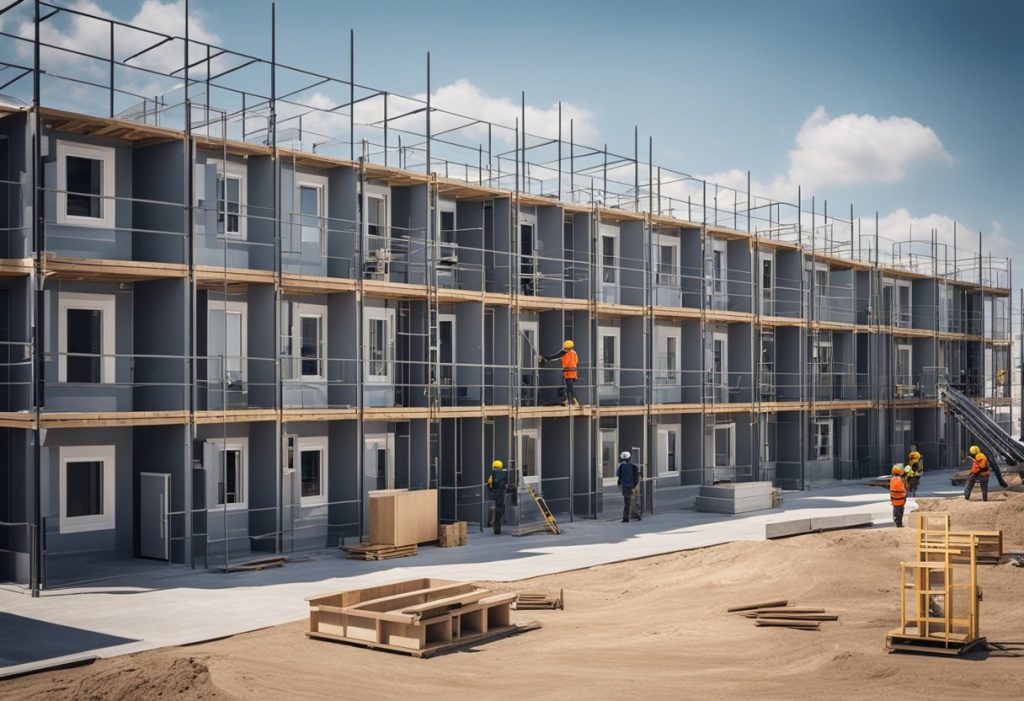Prefab Hotel Investing: Passive Income in Modular Hospitality

Prefab hotel construction is transforming the hospitality industry with innovative building methods that slash construction timelines and costs. Investing in modular hotel projects can yield 30% faster completion times while maintaining quality standards comparable to traditional construction methods.
Modular hotel construction offers a compelling investment opportunity in the hospitality sector. The approach requires significant upfront capital, with manufacturers typically requesting up to 50% of the total project budget before construction begins. This financial structure creates unique opportunities for investors ready to capitalize on the growing demand for efficient hotel development.
The market shows strong growth potential, with modular hotel construction increasing by 31% in a recent year-over-year period. Major hotel chains are embracing this construction method, signaling a shift in industry preferences and creating new investment possibilities.
Key Takeaways
- Modular hotel construction reduces build times by 30% compared to traditional methods
- Upfront capital requirements create barriers to entry that savvy investors can leverage
- Major hotel chains’ adoption of prefab construction indicates strong market potential
Investment Fundamentals in Prefab Hotels

Prefabricated hotel construction represents a significant shift in hotel development, combining modern manufacturing efficiency with traditional hospitality investment principles. Marriott’s commitment to sign 50 hotel deals using prefab elements demonstrates the growing mainstream acceptance of this approach.
Understanding Prefab Hotel Investment
Prefab hotel investments require a different evaluation approach than traditional hotel developments. Your initial cost analysis must account for factory production, transportation, and on-site assembly.
Extended-stay properties particularly suit prefab construction due to standardized room layouts and predictable demand patterns.
Key investment considerations:
- Factory production costs
- Transportation logistics
- Land availability
- Site preparation requirements
- Assembly timeline
- Local building codes compliance
Advantages of Prefab Hotel Construction
Quality control in factory settings ensures consistent room standards and reduces construction defects, similar to branded real estate. Your build time can decrease by 30-50% compared to traditional construction methods.
Environmental benefits include:
- Reduced construction waste
- Lower carbon emissions from transportation
- Energy-efficient manufacturing processes
- Minimal site disruption
Design flexibility allows you to modify room configurations while maintaining standardization. Your property can incorporate sustainable features like energy-efficient windows and advanced HVAC systems.
Financial Modeling for Prefab Investments
Your financial model must account for unique prefab cost structures. Initial manufacturing expenses may be higher, but reduced labor and shorter construction timelines offset these costs.
Investment metrics to track:
- Manufacturing costs per room
- Transportation and installation expenses
- Construction timeline reduction value
- Labor cost savings
- ROI acceleration from faster opening dates
Alternative financing options like crowdfunding platforms now support prefab hotel projects, allowing you to access diverse capital sources.
Operational Insights and Market Trends

Prefab hotel investments demonstrate strong growth potential with 94% of investors planning to maintain or increase investments in 2025. The modular construction approach reduces timelines by 40% while cutting waste by 30%.
Global Market Analysis for Prefab Hotels
The prefab hotel market shows robust expansion in North America and Europe, with Asia-Pacific emerging as a key growth region. Project timelines average 6-8 months for a 100-room prefab hotel, compared to 14-18 months for traditional construction.
Modular buildings address the critical labor shortage through factory-based assembly, requiring 60% fewer on-site workers.
Key advantages for investors:
- 25-35% reduction in construction costs
- 90% less on-site waste
- Standardized quality control
- Predictable delivery schedules
Evolving Travel Demand and its Impact
Your target markets now prioritize sustainable accommodations. Prefab hotels meet these expectations through:
Energy-efficient features reduce operational costs by 40-50%:
- Integrated solar panels
- Smart climate control systems
- LED lighting throughout
- Enhanced insulation materials
Modern travelers appreciate minimal environmental impact, driving 28% higher booking rates for green-certified properties.
Key Players in Prefab Hotel Construction
Leading manufacturers have developed specialized hotel modules with durability ratings matching traditional construction. Quality finishing options now include:
Premium Features:
- Sound-dampening walls
- Custom façade options
- Integrated smart room controls
- Modular bathroom pods
Project management improvements show 85% faster deployment through streamlined delivery and installation processes.
Top global suppliers maintain strict quality standards while offering diverse design options for different market segments.
Frequently Asked Questions

Successful prefab hotel investments require understanding modular construction costs, manufacturing relationships, and investment requirements ranging from $142,700 to $168,800 per room.
How does investing in modular hotel construction compare to traditional hotel development?
Modular hotel construction requires higher upfront capital, with manufacturers often requesting 50% of the total project budget initially for raw materials.
The construction timeline moves faster since components are fabricated offsite while site preparation work takes place.
What are the benefits of investing in prefab hotel rooms?
Prefabricated construction delivers energy-efficient and low-maintenance hotels, reducing ongoing operational costs.
Manufacturing in controlled factory environments ensures consistent quality and precise specifications across all units.
Can individual investors purchase prefab hotel rooms, and how does that process work?
You can invest through hotel development companies that specialize in modular construction projects.
Investment structures typically involve becoming a limited partner or participating in a dedicated hotel investment fund as a strategy for generating passive income.
What are the key factors to consider when choosing a prefab hotel room manufacturer?
Evaluate the manufacturer’s track record of completed hotel projects and their financial stability.
Verify their production capacity, quality control processes, and ability to meet project timelines.
In terms of ROI, how do prefab hotels perform against conventional hotels?
Prefab hotels often achieve faster time-to-market, allowing earlier revenue generation.
Lower maintenance costs and improved energy efficiency contribute to stronger long-term, relatively passive returns.
What are the typical challenges faced in the construction and operation of modular hotels?
Transportation logistics and crane requirements for module installation can impact project costs.
Securing construction financing can be more complex due to the unique payment structure required by manufacturers.
Coordinating between offsite manufacturing and onsite assembly requires precise project management.
Ever wish you could analyze properties like the pros?
Save time and make smarter investment decisions with the most powerful real estate analysis software on the market. Try DealCheck now!

Dive deep into the world of real estate investment with this comprehensive case study that brings theory to life.
Investment Real Estate Analysis: A Case Study offers an unparalleled look at the decision-making process behind successful property investments. Follow along as we dissect a real-world scenario, revealing the critical factors that seasoned investors consider before making a move.
From crunching numbers to assessing market conditions, this book walks you through every step of the analysis process. Learn how to evaluate potential investments like a pro, understanding key metrics such as cap rates, cash-on-cash returns, and internal rate of return.
Whether you’re a novice investor or looking to refine your skills, this case study will equip you with the tools to make informed investment decisions in the competitive real estate market.
Get your copy now from your favorite bookseller:
- Amazon
- Books2Read for Apple, Barnes & Noble, Kobo, Scribed, and 8 more sellers with both eBook and paperback options available
- Payhip as a downloadable PDF
Ready to take your business to the next level?
- Visit our learning center
- Learn more about our consulting services